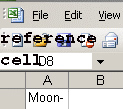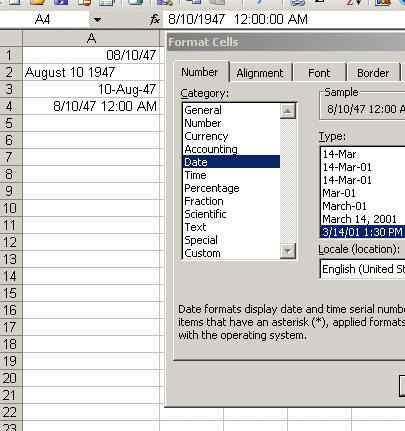
Thursday December 08

As we begin to learn Excel - a spreadsheet that we can do lots with take note of what else there is going on in the world of technology. If we can learn Excel what do you make of a rat flying an F-22 jet? (this is no joke)
A "brain" grown from 25,000 neural cells extracted from a single rat embryo has been taught to fly an F-22 jet simulator by scientists at the University of Florida.
View the story and cartoon of it at http://www.theage.com.au/articles/2004/12/06/1102182227308.html
Explore the worksheet using the mouse and keyboard
2. Creating a Workbook: Menu Option
Entering a Date or Time Manually
Entering the Current Date or Time Automatically
Today we are starting with Excel.
There are a lot of different levels in this class of knowing Excel but we will go over it all together step-by-step.
We are using Microsoft Excel 2003 which may be different from what you learned on.
Create a folder in your Word > Two folder labeled Excel Word > Two > Excel
Below are terms you will need to know and you will be quizzed on in two weeks (before holidays).
Open a new word document in Word > Two > Excel and save it as Terms copy and paste the terms in the table below into your word document
|
Cell |
The intersection of a column and row. Information is stored in cells. |
|
Cell Pointer |
The cell pointer is similar to Word's insertion point. It selects or marks the current cell (where the next activity is going to take place). The Excel pointer changes shape depending on location and corresponding function. For more information, refer to Pointer Shapes (see below for pointer shapes). In Excel try the pointer and see how it changes. |
|
Cell References |
The address (consisting of the column and row IDs) of a specific cell. The current cell location is displayed in the upper left corner of the worksheet. |
|
Column |
A vertical group of cells within a worksheet. |
|
Formula bar |
A set of instructions which a calculation based on numbers entered in the cell or numbers entered in other cells (referred to by cell references). All formulas begin with the equal sign ( = ). |
|
Function |
A pre-programmed formula. The function performs the calculation based on the cells referenced in the function. All functions begin with the equal sign ( = ). |
|
Range |
A group of cells. Ranges are often referenced for formulas, printing, and designating information to be copied or cut. Ranges can be selected by dragging (also referred to as painting) over the cells. |
|
Row |
A horizontal group of cells within a worksheet. |
|
Sheet Tabs |
Tabs that appear at the bottom of the workbook window, which display the name of each worksheet. By default it says ‘sheet 1’ ‘sheet 2’ ‘sheet 3’ See Worksheet |
|
Value |
A number that can be used in an Excel calculation. |
|
Workbook |
A collection of worksheets contained within a single file. |
|
A single layer or
single sheet within the workbook. A worksheet can contain data, charts,
or both. Instead of compiling all of your information into one
worksheet, you can create several worksheets within the one workbook
file. With this organization, similar information is grouped together to
make it easier to locate and use. The worksheets for your workbook will
vary based on its content and purpose. |
As with other Microsoft programs, the shape of the pointer changes as you are working in Excel. Each pointer shape is communicating something about how Excel is working. The shape of the pointer when you click and drag a cell will greatly influence the results of the click and drag.
|
Cursor Shape |
When it does it |
What it does |
|
|
The default pointer shape. |
Moves cell pointer or selects a range of cells |
|
|
Appears when the pointer is on a border (column, row, or window). When adjusting row height, the arrows point up and down. When adjusting column width, the arrows point right to left. |
Adjusts the column width, row height, or window size |
|
|
Appears when you are editing the contents of a cell. |
Moves the insertion point within the cell |
|
Windows: |
Appears when you have a graphic that may be moved. |
Moves the selected graphic to the new location. |

Figure SEQ Figure \* ARABIC 1 Excel table
Put information in different active cells – see how the cursor changes
An Excel workbook contains multiple worksheets. Worksheets can be used to group information together. A worksheet can contain data, charts, or both.
Windows:
1. From the
File menu, select New…
The New Workbook task pane appears.
2. Under
New, select Blank workbook
A new workbook appears.
A cell containing text and numbers or only text cannot be used in formulas, even if numbers exist with the alphabetic characters.
I. Select the cell where you want to enter text
II. Type the alpha-numeric text that should be in the cell
III. To fit the text into your cell use one of the options in Format > Alignment > (toward the left bottom) > Text control - see below

In worksheet 3 we will put dates the way you want to see them.
Put each day of the week for one week across.
1. Select the cell where you want to enter the date or time
2.
To enter a date, type the date in one of the following formats:
6/23/2004, 6-23-2004, or June 23, 2004
To enter a time, type the time
NOTE: To indicate AM or PM, leave a space and
press [Shift] + [A] or [P],
respectively.
3. To accept the information, press [Enter] or [return]
4. To make the date appear the way you want go to Format > Cells > Number > Date and in the right hand side pick the way you want the date to appear. For example, if you want more room in your spreadsheet you may want 3/14 if you want the whole thing then select the day – month - year

1. To enter today's date, press [Ctrl] + [;]